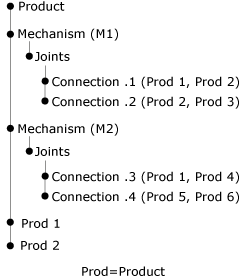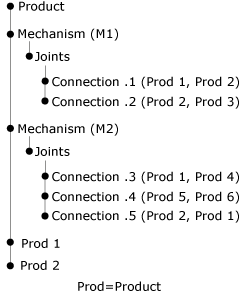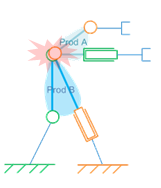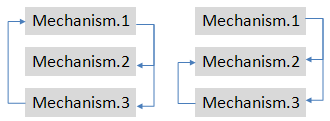More about Mechanism Assemblies | ||||||
|
| |||||
Key terms
Macro mechanism, assembled mechanism, assembly of mechanisms, and disjoint mechanisms play a prominent role in handling macro mechanisms and need to be defined more accurately.
- Macro mechanism
- A mechanism that assembles other mechanisms. A macro mechanism is linked to the mechanisms referenced under it. Any change made to an assembled mechanism is propagated to the macro mechanism.
- Assembled mechanism
- A mechanism representation that is referenced in a macro mechanism.
- Assembly of mechanisms
- A collection of mechanisms that are referenced in a macro mechanism—also referred to as a multilevel mechanism.
- Disjoint mechanisms
- Mechanisms that do not include multiple joints involving the same two products are disjoint—also referred to as independent mechanisms.
The following figure illustrates a typical example of disjoint mechanisms.

In the above product structure M1 and M2 are two mechanisms including joints marked Connection.n, and products that are involved in the joints marked Prod 1, Prod 2, etc. In this example, products that are involved in the joints included in M1 are not involved in the joints included in M2 and vice-versa. They are disjoint because Connection.1 and Connection.3 share only one product (Prod 1).

The above figure provides a more detailed example
- In the left configuration, the mechanisms (identified in green and in orange) are fully disjoint.
- In the right configuration, the same mechanisms are linked but disjoint.
- Dependent mechanisms
- Two types of situations are identified. Mechanisms which share a joint are dependent. Mechanisms which own respectively a joint that involves the same products are dependent. Dependent mechanisms are not recommended in mechanism assemblies, see Diagnosing Assembly of Mechanisms Incidents.

In the above product structure, M1 and M2 are dependent because Connection.1 and Connection.5 involve the same products.

The above figure illustrates a typical example of dependent mechanisms. Both the orange and the green mechanisms include a joint that impacts the same two products, marked Prod A and Prod B.
- Cyclic mechanism assembly
- Assembles the same mechanism twice or contains a loop relationship within the assembly process.
![]()
Cyclicity and Assembly of Mechanisms
Two types of cyclicity situations can occur: loops or a mechanism assembled twice. Cyclicity is not permitted for mechanism assemblies.
The following figures illustrate a loop-related cyclicity (left), and a cyclicity caused by a disjoint mechanism that is assembled twice within a macro mechanism (right): 
- In the left figure, a loop occurs. Mechanism.1 assembles Mechanism.2 and Mechanism.3, and Mechanism.3 assembles Mechanism.1. Both Mechanism.1 and Mechanism.3 are cyclic.
- In the right figure, only Mechanism.1 is cyclic—or recurring. Mechanism.2 is assembled twice. Mechanism.1 assembles Mechanism.2 and Mechanism.3, and in turn, Mechanism. 3 assembles Mechanism.2. (M1 > M2, and M1 > M3 > M2).
![]()
Diagnosing Assembly of Mechanisms Incidents
To understand the incidents in an assembly of mechanisms and solve the errors, you can access a report using the Incident Diagnosis function. See Diagnosing Computation Incidents for more information.
Examples of Errors and Warnings
The following types of errors can be detected when using the mechanism assembly function.
- Cyclic Assembly
- If a cyclic mechanism assembly is detected, the following message is displayed:
The mechanism assembly contains a cycle. The mechanism assembly contains the following cycle: MacroMechanismRep -> MechProducingCycle\PrismaticMechanism.1 -> PrismaticMechanismRep\PrismaticMechanism.1. The last mechanism is already assembled directly or indirectly. Cycles are forbidden.
- Broken link
- If a broken link is detected, the following message is displayed:
A broken link to a mechanism should be isolated. The link number 2 of the mechanism assembly is broken. This link should be isolated.
- Not Disjoint mechanisms
- If mechanisms that are included in an assembly of mechanisms are not disjoint, the following message is displayed:
Mechanisms are not disjoint. The engineering connection Fix.1 of the mechanism PrismaticMechanismRep\PrismaticMechanism.1 shares the same impacted products as the engineering connection Fix 1 of mechanism MechallJoints. Thus the mechanism PrismaticMechanismRep\PrismaticMechanism and the mechanism MechallJoints are not disjoint. Consequently, the mechanism assembly can be overconstrained or can include interdenpendent commands.